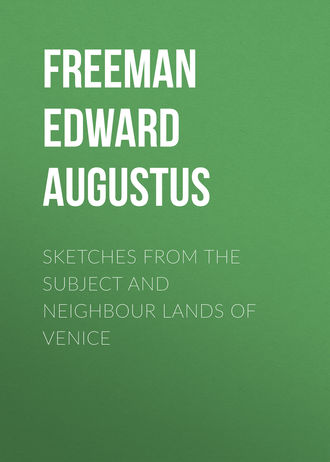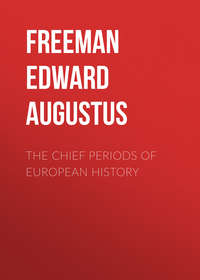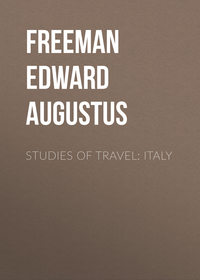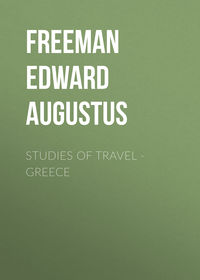 полная версия
полная версияSketches from the Subject and Neighbour Lands of Venice

CABOGA HOUSE, GRAVOSA.
This, we may note by the way, is the house in whose garden the column from the palace, wrought with the Judgement of Solomon, still lies hid. Indeed we might go further away from the palace than the loggie of the houses. At Ragusa art extends itself to objects which might have been thought hardly capable of artistic treatment. Stone is common, and it is used for all manner of purposes. Among other things stone vine-props are common. In not a few cases these take the form of columns, slenderer doubtless than the rules of classical proportion, realizing the description of Cassiodorus about the tall columns like reeds, the lofty buildings propped as it were on the shafts of spears. Sometimes the columns are fluted or twisted; in a great many cases they have real capitals, with various forms according to taste. It often happens that a row of such columns, whether on a house-top or in a vineyard, really becomes an architectural object, a genuine colonnade. Here the style, the construction at least, is Greek rather than Romanesque; but the principle is the same. A good and rational artistic form is kept in use, and is applied to a purpose for which it is fitted.
All these examples, the palace, the dogana, the houses, the remains in the Dominican church, we might almost say the vine-props, look one way. All point to the existence of a Ragusan style, to an unbroken Romanesque tradition, which could not wholly withstand the inroads of the pseudo-Gothic of Italy, but which could at least keep its place alongside of the intruder. All help us to see how instructive must have been the course of architectural developement at Ragusa, and how much has been lost to the history of art by the destruction of so many of the buildings of the city in the great earthquake. It is easy to see that for a long time the struggle between the genuine Romanesque tradition, the Italian Gothic, and the new ideas of the Renaissance, must have been very hard. How long real Romanesque went on, bringing in new developements of its own, but remaining still as truly Romanesque by unbroken succession as anything at Pisa or Durham, is shown by the noble arches of the palace, and the still later dogana. The slight touch of Renaissance in some of the capitals of the palace in no sort takes away from the general purity of the style. Still over these noble arcades are windows of Venetian Gothic, and one of the most characteristic features of the Ragusan streets are the flat-headed doorways. But these, alternating as they do with pointed ones, help to make out our case. On the other hand, it is equally plain that in some cases the Renaissance came in early. A little chapel by the basin at Ombla, bearing date 1480, is in a confirmed Renaissance style, and looks more like 1580. Yet of true Renaissance there is very little. One large house in the city, older than the earthquake, stands quite alone as the kind of thing which might easily have been built in Italy or copied in England. But at Ragusa, in the near neighbourhood of several native doorways of different shapes, of many native vine-props, of several native wells – for wells too take an artistic style and copy the form of a capital – the regular trim Palladian building looks strangely out of place. Even in the Stradone, where in the houses there is little architecture of any kind, a touch of ancient effect is kept in the form of the shops, with their arches and stone dressers, thoroughly after the mediæval pattern. And some architectural features never died out. The round window with tracery goes on long after every other feature of Romanesque or Gothic is forgotten. It is to be seen in endless little chapels of very late date in the city and suburbs, sometimes standing apart, sometimes attached to private houses.
The plain conclusion from all this is that at Ragusa the use of the round arch for the chief arcades never went out of use; that it always remained as a constructive feature, passing from Romanesque to Renaissance, if fully developed Renaissance can at Ragusa be said to exist at all, without any intermediate Gothic stage, and continuing to invent and adopt any kind of ornament which suited its constructive form. In windows and doorways, on the other hand, the forms of the Italian Gothic came in and stood their ground till a very late date. In most cases we wish the Venetian features away; in the upper story of the palace they may be endured; but conceive palace, dogana, Caboga house, with smaller arcades and windows to match the great constructive arches. Such buildings as these, now so few, make us sigh over the effects of the great earthquake, and over the treasures of art which it must have swallowed up. If Ragusa, in her earlier day, contained a series of churches to match her civic arcades, she might claim, in strictly artistic interest, to stand alongside of Rome, Ravenna, Pisa, and Lucca. Her churches of the fifteenth century must have been worthy to rank with anything from the fourth century to the twelfth. One longs to be able to study the Ragusan style in more than these few examples. It is not indeed absolutely peculiar either to Ragusa or to Dalmatia. Many buildings in Italy and Sicily show a good native Romanesque tradition, holding its own against the sham Gothic, and showing a good fight against the Renaissance. Not a few arcades, not a few cloisters, of this kind may be found here and there. But it would be hard to light on another such group of buildings as the palace, the dogana, and their fellows. In any case the Dalmatian coast may hold its head high among the artistic regions of the world. It is no small matter that the harmonious and consistent use of the arch and column should have begun at Spalato, and that identically the same constructive form should still be found, eleven ages later, putting forth fresh and genuine shapes of beauty at Ragusa.
A TRUDGE TO TREBINJE
1875[This paper, as giving the impressions of a first visit to the soil of Herzegovina, during an early stage of the war, has been reprinted, with the change of a few words, as it was first written.]
The first step which any man takes beyond the bounds of Christendom can hardly fail to mark a kind of epoch in his life. And the epoch becomes more memorable when the first step is taken into an actual "seat of war," where the old strife between Christian and Moslem is still going on with all the bitterness of crusading days. In Europe it is now in one quarter only that such a step can be made by land with somewhat less of formality than is often needed in passing from one Christian state to another. It is now only in the great south-eastern peninsula that the frontier of the Turk marches upon the dominions of any Christian power; and, now that Russia and the Turk are no longer immediate neighbours, the powers on which his frontier marches are, with one exception, states which have been more or less fully liberated from his real or asserted dominion. That exception is to be found in the Hadriatic dominions of Austria; and certainly no more striking contrast can be imagined than that which strikes the traveller as he passes on this side from Christian to Moslem dominion. Let us suppose him to be at Ragusa, with his ears full of tales from the seat of war, all of which cannot be true, but all of which may possibly be false. The insurgents have burned a Turkish village. No; it was a Christian village, and the Turks burned it. The Turks have murdered seven Roman Catholics. The Turks have murdered seventy Roman Catholics – a difference this last which may throw light on some cases of disputed numbers in various parts of history. The Turks have threatened Austrian subjects. Austrian subjects have attacked the Turks. An Italian has had his head cut off by the Turks just beyond the frontier. A Turkish soldier has been found lying dead in the road a little further on. These two last stories come on the authority of men who have seen the bodies, so that we have got within the bounds of credible testimony. Meanwhile the one thing about which there is no doubt is the presence and the wretchedness of the unhappy Herzegovinese women and children whose homes have been destroyed either by friends or by enemies, and who are seeking such shelter as public and private charity can give in hospitable Ragusa. All these things kindle a certain desire to get at least a glimpse of the land where something is certainly going on, though it may not be easy to know exactly what. Between Ragusa and Trebinje there is just now no actual fighting; the road is reported to be perfectly safe; only it is advisable to get a passport visé by the Turkish consul. The passports are visé, but, so far for the credit of the Turks, it must be added that, though duly carried, they were never asked for. The party, four in number – three English and one Russian – presently set forth from Ragusa. It is now as easy to get a carriage at Ragusa as in any other European town. So our party sets out behind two of the small but strong and sure-footed horses of the country, to get a glimpse of what, to two at least of their number, were the hitherto unknown lands of Paynimrie.
As long as we are on Austrian territory there is nothing to fear or to complain of but those evils which no kings or laws can cure. The day was rainy – so rainy that a word was once or twice murmured in favour of turning back; but it was deemed faint-hearted to turn again in an undertaking which had been once begun. On the Austrian side the rain was certainly to be regretted, as damping the charm of the glorious prospect from the zigzag road which winds up from Ragusa to the frontier point of Drino. Ragusa, nestling among hills and forts and castles, the isle of La Croma keeping guard over the haven which has ceased to be a haven, the wide Hadriatic stretching to the horizon, form a picture surpassed by but few pictures even in the glorious scenery of the Dalmatian coast. On the other side, it was perhaps no great harm if the rain made the savage land between Drino and Trebinje seem more savage still. At the top of the height the Austrian guard-house is reached, a guard-house which the line of the frontier causes to be overlooked by a Turkish fort above it. The guardians of the borders of Christendom look wild enough in their local dress; but the wildness is all outside, though one certainly does not envy them their watch on so dreary a spot. Hard by is the place where the Italian lost his head; but the Italian was openly in the ranks of the insurgents; so, though the thought is a little thrilling, our present travellers feel no real danger for their heads. The frontier is now passed; we are in the land where the Asiatic and Mahometan invader still holds European and Christian nations in bondage. We see no immediate sign of his presence. The Turkish guard-house is at some distance from the Austrian, in order to watch the pass on the other side, where the road begins to go down towards Trebinje, as the Austrian guards the road immediately up from Ragusa. But, if as yet we see not the Turk, we feel his presence in another way. In one point at least we have suddenly changed from civilization to barbarism. The excellently kept Austrian road at once stops – that is to say, its excellent keeping stops; the road goes on, only it is no longer mended in Austrian but in Turkish fashion – a fashion of which the dullest English highway board would perhaps be ashamed. We presently begin to see something cf the land of Herzegovina, or at least of that part of it which lies between Ragusa and Trebinje. It may be most simply described as a continuous mass of limestone. The town lies in a plain surrounded by hills, and it would be untrue to say that that plain is altogether without trees or without cultivation. Close to the town tobacco grows freely, and before we reach the town, as we draw near to the river Trebenitza, the dominion of utter barrenness has come to an end. But the first general impression of the land is one of utter barrenness, and for a great part of our course, long after we have come down into the lower ground, this first general impression remains literally true. It is not like a mountain valley or a mountain coast, with a fringe of inhabited and cultivated land at the foot of the heights. All is barren; all is stone; stone which, if it serves no other human purpose, might at least be used to make the road better. That road, in all its Turkish wretchedness, goes on and on, through masses of limestone of every size, from the mountains which form the natural wall of Trebinje down to lumps which nature has broken nearly small enough for the purposes of MacAdam. Through the greater part of the route not a house is to be seen; there are one or two near the frontier; there is hardly another till we draw near to the town, when we pass a small village or two, of which more anon. Through the greater part of the route not a living being is to be seen. In such a wilderness we might at least have looked for birds of prey; but no flight of vultures, no solitary eagle, shows itself. As for man, he seems absent also, save for one great exception, which exception gives the journey to Trebinje its marked character, and which brings thoroughly home to us that we are passing through a seat of war.
It will be remembered that, early in the war, the insurgents were attacking the town of Trebinje, and, among later rumours, were tales of renewed attacks in that quarter. But at the time of our travellers' journey the road was perfectly open, and no actual fighting was going on in the neighbourhood. Trebinje however was on the watch: the plain before the town was full of tents, and, long before the town or the tents were within sight, the sight of actual campaigners gave a keen feeling of what was going on. Flour is to be had in the stony land only by seeking it within the Austrian frontier, and to the Austrian frontier accordingly the packhorses go, with a strong convoy of Turkish soldiers to guard them. Twice therefore in the course of their journey, going and coming back, did our travellers fall in with the Turkish troops on their way to and from the land of food. For men who had never before seen anything of actual warfare there was something striking in the first sight of soldiers, not neat and trim as for some day of parade, but ragged, dirty, and weather-stained with the actual work of war. And there was something more striking still in the thought that these were the old enemies of Europe and of Christendom, the representatives of the men who stormed the gates of the New Rome and who overthrew the chivalry of Burgundy and Poland at Nikopolis and at Varna. But the Turk in a half-European uniform has lost both his picturesqueness and his terrors, and the best troops in Europe would be seen to no great advantage on such a day and on such a march. And perhaps Turkish soldiers, like all other men and things, look differently according to the eyes with which they are looked at. Some eyes noticed them as being, under all their disadvantages, well-made and powerful-looking men. Other eyes looked with less pleasure on the countenances of the barbarians who were brought to spread havoc over Christian lands. All however agreed that, as the armed votaries of the Prophet passed before them, the unmistakeable features of the Æthiop were not lacking among the many varieties of countenance which they displayed. But the Paynim force, though it did no actual deed of arms before the eyes of our party, did something more than simply march along the road. The realities of warfare came out more vividly when, at every fitting point, skirmishers were thrown off to occupy each of the peaked hills and other prominent points which line the road like so many watchtowers.
The armed force went and came back that day without any need for actually using their arms. Insurgent attacks on the convoys are a marked feature of the present war; but our travellers had not the opportunity of seeing such a skirmish. Still before long they did see one most speaking sign of war and its horrors. By the banks of the Trebenitza a burned village first came in sight. The sight gives a kind of turn to the whole man; still a burned village is not quite so ugly in reality as it sounds in name. The stone walls of the houses are standing; it is only the roofs that are burned off. But who burned the village, and why? He would be a very rash man who should venture to say, without the personal witness of those who burned it, or saw it burned. Was it a Christian village burned by Turks? Was it a Turkish village burned by Christians? Was it a Christian village burned by the insurgents because its inhabitants refused to join in the insurrection? Was it a Christian village burned by its own inhabitants rather than leave anything to fall into the hands of the Turks? If rumour is to be trusted, cases of all these four kinds have happened in the course of the war. All that can be said is that the village has a church and shows no signs of a mosque, and that, while the houses were burned, the church was not. The burned village lay near a point of the river which it is usually possible to ford in a carriage. This time however, the Trebenitza – a river which, like so many Greek rivers, loses itself in a katabothra– was far too full to be crossed in this way, and our travellers had to leave their carriage and horses and get to Trebinje as they could. After some scrambling over stones, a boat was found, which strongly suggested those legends of Charon which are far from having died out of the memory of the Christians of the East. A primitive punt it was, with much water in it, which Charon slowly ladled out with a weapon which suggested the notion of a gigantic spoon. Charon himself was a ragged object enough, but, as became his craft, he seemed master of many tongues. We may guess that his native speech would be Slave, but one of the company recognized some of his talk for Turkish, and the demand for the two oboli of old was translated into the strange phrase of "dieci groschen." To our travellers the words suggested was the expiring coinage of the German Empire; they did not then take it how widely the groat had spread its name in the south-eastern lands. At first hearing, the name sounded strange on the banks of the Trebenitza; but in the absence of literal groats or groschen, the currency of the Austro-Hungarian monarchy was found in practice to do just as well. Then our four pilgrims crossed and crossed again, the second time with much gladness of heart, as for a while things looked as if no means of getting back again were forthcoming, and it was not every one of the party that had a heart stout enough even to think of trying to swim or wade. Charon's second appearance was therefore hailed with special pleasure.
From the crossing-place to Trebinje itself our travellers had to trudge as they could along a fearfully rough Turkish path – not rougher though than some Dalmatian and Montenegrin paths – till they reached the town itself, which this delay gave them but little time to examine. The suburbs stretched along the hillside; below, the tents of the Turkish troops were pitched on one side; the Mahometan burial-ground lay on the other. After so much time and pains had been spent in getting to Trebinje, a glimpse of Trebinje itself was all that was to be had. But even a glimpse of Eastern life was something, particularly a glimpse of Eastern life where Eastern life should not be, in a land which once was European. It is the rule of the Turk, it is the effect of his four hundred years of oppression, which makes Trebinje to differ alike from Tzetinje and from Cattaro. The dark, dingy, narrow, streets, the dim arches and vaults, the bazaar, with the Turk – more truly the renegade Slave – squatting in his shop, the gate with its Arabic inscription, the mosques with their minarets contrasting with the church with its disused campanile, all come home to us with a feeling not only of mere strangeness, but of something which is where it ought not to be. It is with a feeling of relief that, after our second trudge, our second voyage, our second meeting with the convoy, we reach the heights, we pass the guard-houses, and find ourselves again in Christendom. Presently Ragusa comes within sight; we are in no mood to discuss the respective merits of the fallen aristocratic commonwealths and of the rule of the Apostolic King. King or Doge or Rector, we may be thankful for the rule of any of them, so as it be not the rule of the Sultan. The difference between four hundred years of civilized government and four hundred years of barbarian tyranny has made the difference between Ragusa and Trebinje.
CATTARO
1875[I have left this paper, with a few needful corrections, as it was published in March 1876. Since then, it must be remembered, much has changed, especially in the way of boundaries – to say nothing of a carriage-way to Tzetinje. Neither Cattaro nor Budua is any longer either the end of Christendom or the end of the Dalmatian kingdom of the Austrian. That kingdom has been enlarged by the harbour of Spizza, won from the Turk by Montenegrin valour and won from the Montenegrin by Austrian diplomacy. But Christendom must now be looked on as enlarged by the whole Montenegrin sea-coast, a form of words which I could not have used either in 1875 or in 1877. Of this sea-coast I shall have something to say in another paper.]
The end of a purely Dalmatian pilgrimage will be Cattaro. He who goes further along the coast will pass into lands that have a history, past and present, which is wholly distinct from that of the coast which he has hitherto traced from Zara – we might say from Capo d'Istria – onwards. We have not reached the end of the old Venetian dominion – for that we must carry on our voyage to Crete and Cyprus. But we have reached the end of the nearly continuous Venetian dominion – the end of the coast which, save at two small points, was either Venetian or Ragusan – the end of that territory of the two maritime commonwealths which they kept down to their fall in modern times, and in which they have been succeeded by the modern Dalmatian kingdom. After Cattaro and the small district of Budua beyond it, the Venetian territory did indeed once go on continuously as far as Epidamnos, Dyrrhachion, or Durazzo, while, down to the fall of the Republic, it went on, in the form of scattered outposts, much farther. But, for a long time past, Venice had held beyond Budua only islands and outlying points; and most of these, except the seven so-called Ionian Islands and a few memorable points on the neighbouring mainland, had passed away from her before her fall. Cattaro is the last city of the present Austrian dominion; it is, till we reach the frontier of the modern Greek kingdom, the last city of Christendom. The next point at which the steamer stops will land the traveller on what is now Turkish ground. But the distinction is older than that; he will now change from a Slavonic mainland with a half-Italian fringe on its coast to an Albanian, that is an Old-Illyrian, land, with a few points here and there which once came under Italian influences. It is not at an arbitrary point that the dominion in which the Apostolic King has succeeded the Serene Republic comes to an end. With Cattaro then the Dalmatian journey and the series of Dalmatian cities will naturally end.
Cattaro is commonly said to have been the Ascrivium or Askrourion of Pliny and Ptolemy, one of the Roman towns which Pliny places after Epidauros – that Epidauros which was the parent of Ragusa – towards the south-east. And, as it is placed between Rhizinion and Butua, which must be Risano and Budua, one can hardly doubt that the identification is right. But though Ascrivium is described as a town of Roman citizens, it has not, like some of its neighbours, any history in purely Roman times. It first comes into notice in the pages of Constantine Porphyrogenitus, and it will therefore give us for the last time the privilege of studying topography in company with an Emperor. In his pages the city bears a name which is evidently the same as the name which it bears still, but which the august geographer seizes on as the subject of one of his wonderful bits of etymology. Cattaro with him is Dekatera, and we read:
ὅτι τὸ κάστρον τῶν Δεκατέρων ἑρμηνεύεται τῇ Ῥωμαίων διαλέκτῳ ἐστενωμένον καὶ πεπληγμένον.







